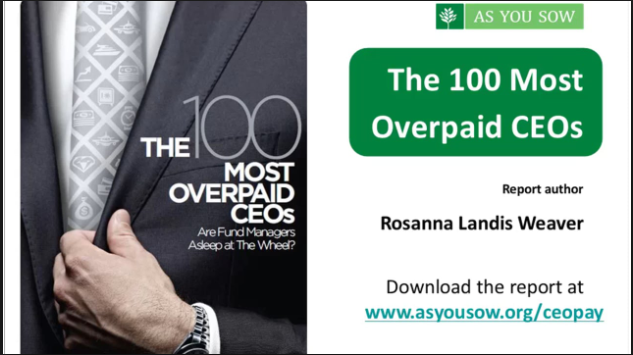Last Friday (August 25), the Securities and Exchange Commission (SEC) adopted final rules implementing the “pay versus performance” disclosure requirement, completing a 12-year journey to fulfill a provision of the 2010 Dodd-Frank Act.
Under the rule, U.S. public companies must provide a new table in their annual proxy filings that contains executive compensation and financial performance measures covering a period of up to five years. While this new rule does not mandate any action that will narrow the pay disparity between executives and workers or reduce wealth inequality in the U.S., the rule requires companies to provide data comparing executive pay to financial performance. This table and the new figures will provide investors some clearer information for the mandatory (advisory) “Say on Pay” votes in every company’s proxy.
As a result, I hope that this makes Rosanna Landis Weaver’s work for As You Sow a little easier as she annually prepares a report on “The 100 Most Overpaid CEOs.” Previously, she had to dig through the not-so-transparent data in the “Compensation Discussion and Analysis” (CD&A), a required part of a company’s annual proxy statement, to generate her figures. Theoretically, the new rule will allow for a more straightforward means of comparison. (Worth noting: Year after year, the report uncovers overpaid CEOs who underperform on “Total Shareholder Return.”)

Some will take issue with the new disclosure rule as it is all about financial performance. Rightfully, socially responsible investors may be concerned because these new required charts do not include non-financial disclosure (i.e., human rights performance or emissions reduction). However, the rule does not preclude a company from including that information.
The new rule may draw companies to better tell their story, rather than bury shareholders in legalese. At the end of the day, the rule is not just about filling out the table, but that companies devote time to develop a narrative that helps investors understand how pay and performance align.
Even after this rulemaking, the SEC has yet to finish the implementation of Dodd-Frank. Perhaps we may see the SEC finalize the long-delayed provision for a clawback rule for accounting missteps mandated by Dodd-Frank. And we may be light years from reducing pay disparity and acting on wealth inequality, but better disclosure is a small step in the right direction.








